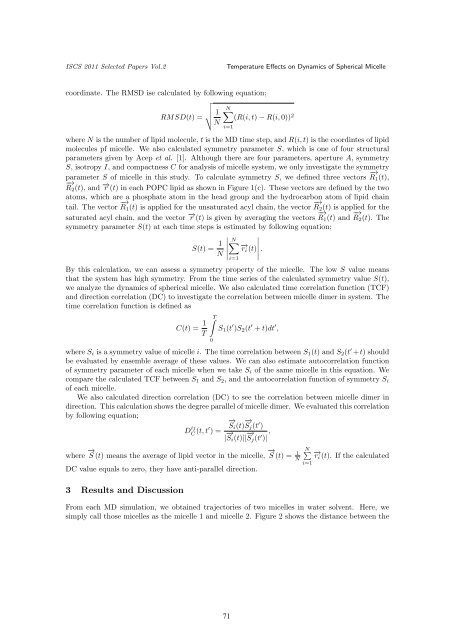RECENT DEVELOPMENT IN COMPUTATIONAL SCIENCE
RECENT DEVELOPMENT IN COMPUTATIONAL SCIENCE
RECENT DEVELOPMENT IN COMPUTATIONAL SCIENCE
You also want an ePaper? Increase the reach of your titles
YUMPU automatically turns print PDFs into web optimized ePapers that Google loves.
ISCS 2011 Selected Papers Vol.2 Temperature Effects on Dynamics of Spherical Micelle<br />
coordinate. The RMSD ise calculated by following equation;<br />
�<br />
�<br />
�<br />
RMSD(t) = � 1<br />
N�<br />
(R(i, t) − R(i, 0))<br />
N<br />
2<br />
i=1<br />
where N is the number of lipid molecule, t is the MD time step, and R(i, t) is the coordintes of lipid<br />
molecules pf micelle. We also calculated symmetry parameter S, which is one of four structural<br />
parameters given by Acep et al. [1]. Although there are four parameters, aperture A, symmetry<br />
S, isotropy I, and compactness C for analysis of micelle system, we only investigate the symmetry<br />
parameter S of micelle in this study. To calculate symmetry S, we defined three vectors −→ R1(t),<br />
−→<br />
R2(t), and −→ r (t) in each POPC lipid as shown in Figure 1(c). These vectors are defined by the two<br />
atoms, which are a phosphate atom in the head group and the hydrocarbon atom of lipid chain<br />
tail. The vector −→ R1(t) is applied for the unsaturated acyl chain, the vector −→ R2(t) is applied for the<br />
saturated acyl chain, and the vector −→ r (t) is given by averaging the vectors −→ R1(t) and −→ R2(t). The<br />
symmetry parameter S(t) at each time steps is estimated by following equation;<br />
S(t) = 1<br />
N<br />
� �<br />
� N� �<br />
�<br />
�<br />
−→ �<br />
ri (t) �<br />
� � .<br />
By this calculation, we can assess a symmetry property of the micelle. The low S value means<br />
that the system has high symmetry. From the time series of the calculated symmetry value S(t),<br />
we analyze the dynamics of spherical micelle. We also calculated time correlation function (TCF)<br />
and direction correlation (DC) to investigate the correlation between micelle dimer in system. The<br />
time correlation function is defined as<br />
C(t) = 1<br />
T<br />
�T<br />
0<br />
i=1<br />
S1(t ′ )S2(t ′ + t)dt ′ ,<br />
where Si is a symmetry value of micelle i. The time correlation between S1(t) and S2(t ′ +t) should<br />
be evaluated by ensemble average of these values. We can also estimate autocorrelation function<br />
of symmetry parameter of each micelle when we take Si of the same micelle in this equation. We<br />
compare the calculated TCF between S1 and S2, and the autocorrelation function of symmetry Si<br />
of each micelle.<br />
We also calculated direction correlation (DC) to see the correlation between micelle dimer in<br />
direction. This calculation shows the degree parallel of micelle dimer. We evaluated this correlation<br />
by following equation;<br />
D ij<br />
C (t, t′ −→<br />
Si(t)<br />
) =<br />
−→ Sj(t ′ )<br />
| −→ Si(t)|| −→ Sj(t ′ )| ,<br />
where −→ S (t) means the average of lipid vector in the micelle, −→ S (t) = 1<br />
N<br />
DC value equals to zero, they have anti-parallel direction.<br />
3 Results and Discussion<br />
N� −→<br />
ri (t). If the calculated<br />
From each MD simulation, we obtained trajectories of two micelles in water solvent. Here, we<br />
simply call those micelles as the micelle 1 and micelle 2. Figure 2 shows the distance between the<br />
71<br />
i=1


